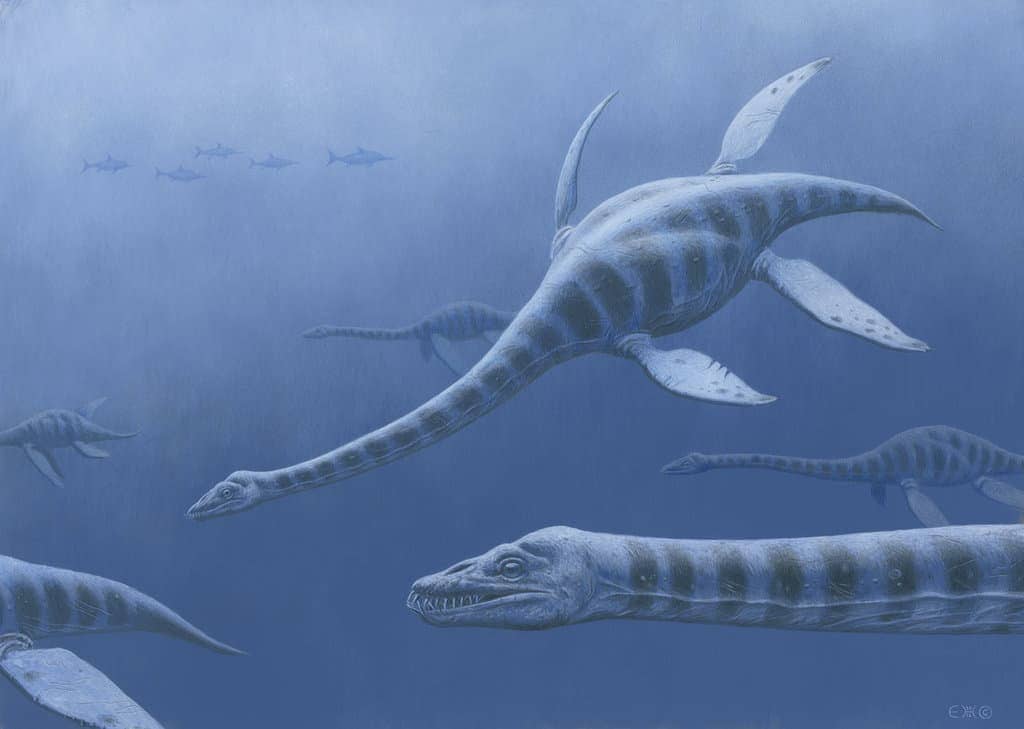
Plesiosaurus — The First Discovered Marine Reptile
Introduction
Plesiosaurus, a marine reptile from the Mesozoic Era of the Early Jurassic period, is often confused as a dinosaur. However, it belongs to the group of plesiosaurs, meaning "near to lizard" in Greek. Being the first of its kind to be discovered, Plesiosaurus has fascinated researchers with its unique anatomy and evolutionary characteristics. Nevertheless, there are still several debates surrounding this ancient creature, including its neck flexibility, locomotion methods, land-walking abilities, and reproductive strategies.
One hypothesis suggests that, like turtles, Plesiosaurus came ashore to nest in the sand due to the absence of evidence supporting live birth in water.
Quick Facts
- Name: Plesiosaurus
- Prehistoric Era: Early Jurassic
- Classification: Piscivore
- Order: Plesiosauria
- Suborder: Plesiosauroidea
- Weight: 200 lbs (90 kg)
- Length: 16 feet (5 meters)
- Height: 3.3 feet (1 meter)
- Maximum Speed: Unknown
- Territory: Europe, North America
About Plesiosaurus
Plesiosaurus thrived in shallow waters, as evidenced by fossils found in shallow sea beds and freshwater lakes. Its long neck played a vital role, allowing it to maintain the right depth for foraging, feeding, and breathing. Unlike marine mammals, Plesiosaurus was a reptile that obtained air from the atmosphere rather than from the ocean.
Physical Characteristics
Plesiosaurus possessed a unique appearance, resembling turtles, with a flat pectoral arch, a broad body, a long neck, large paddle-like flippers with five digits each, and a short tail.
Diet and Feeding
As one of the largest water-dwelling creatures in its time, Plesiosaurus had a powerful jaw and sharp teeth, suggesting it was a formidable predator, particularly for fish and mollusks. However, its teeth and cranial structures were not suited for taking down larger prey or chewing, limiting its diet to small aquatic life that it could easily swallow whole.
Locomotion
Being a water-dwelling reptile, Plesiosaurus used its four large, stiff flippers to move through the water, resembling modern-day turtles. The exact motion of its flippers remains a subject of debate, but some scientists propose a modified combination of rowing and flying styles of locomotion. While Plesiosaurus had a tail, it likely did not contribute significantly to its mobility.
Habitat and Distribution
Plesiosaurus fossils have been discovered predominantly in England and Germany, but findings span across all continents, including North America. This suggests that Plesiosaurus had a widespread distribution in the ocean, moving expansively, akin to many other sea creatures or migratory birds.
Discovery and Significance
The genus Plesiosaurus was discovered and named in 1821 by William Conybeare and Henry De la Beche. It significantly contributed to scientists' modern understanding of sea-bound evolution and life during the Plesiosauroidea period. Recent discoveries have challenged prior assumptions, suggesting that Plesiosaurus likely gave birth to live young rather than laying eggs in the sand.
Unique Characteristics
Plesiosaurus had an intriguing characteristic in the form of gastroliths, or stomach stones. These stones were recovered in significant numbers, and while their exact purpose remains uncertain, it is believed that Plesiosaurus utilized them to aid digestion by grinding harder portions of ingested items, such as mollusk shells.
Conclusion
Plesiosaurus, the first Mesozoic reptile to be discovered, has left an indelible mark on the field of paleontology. Its unique characteristics and significance continue to captivate researchers and enthusiasts alike. Moreover, the fascination with Plesiosaurus has extended into popular culture, with some speculating that the mythical Loch Ness Monster might be a modern-day evolution of this remarkable marine reptile.



